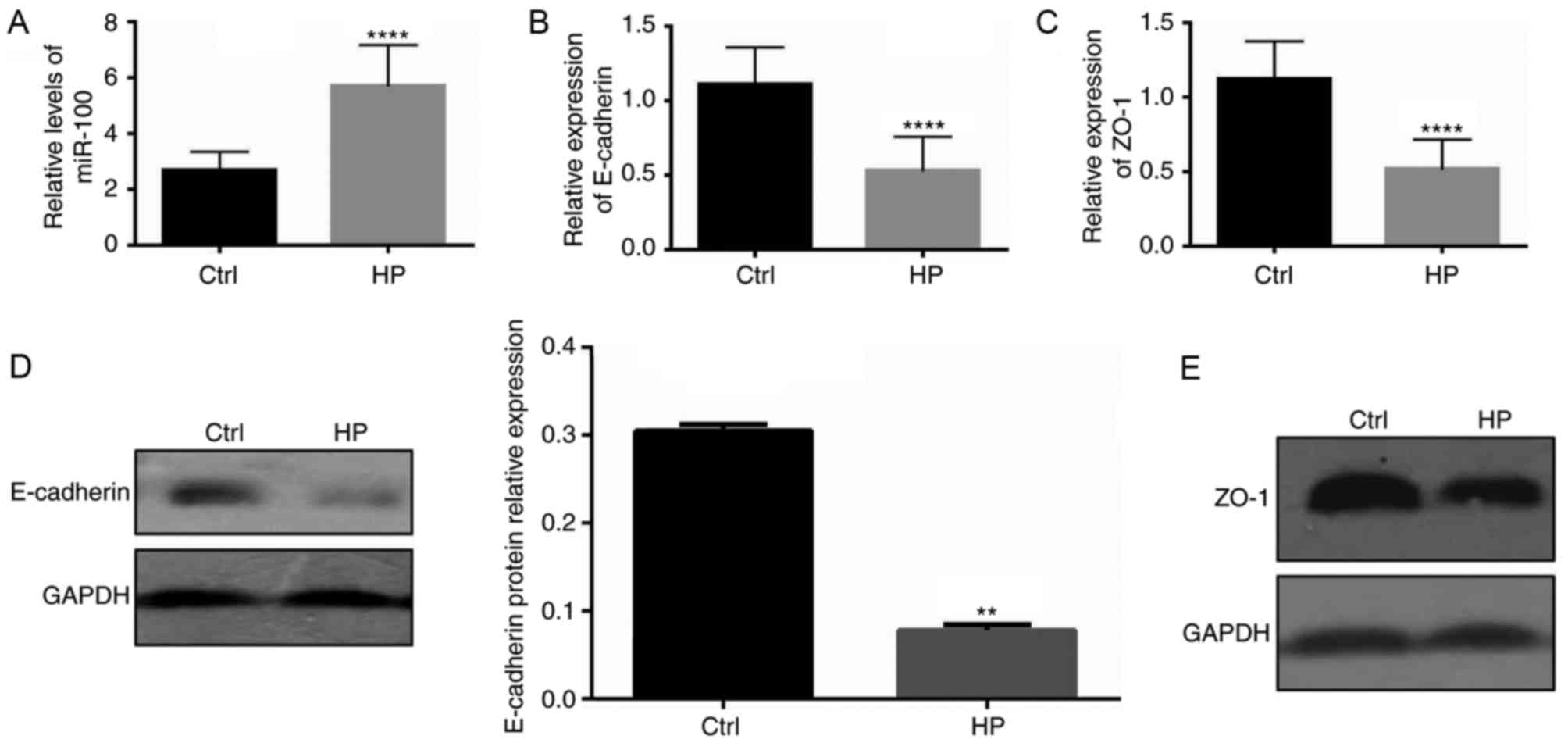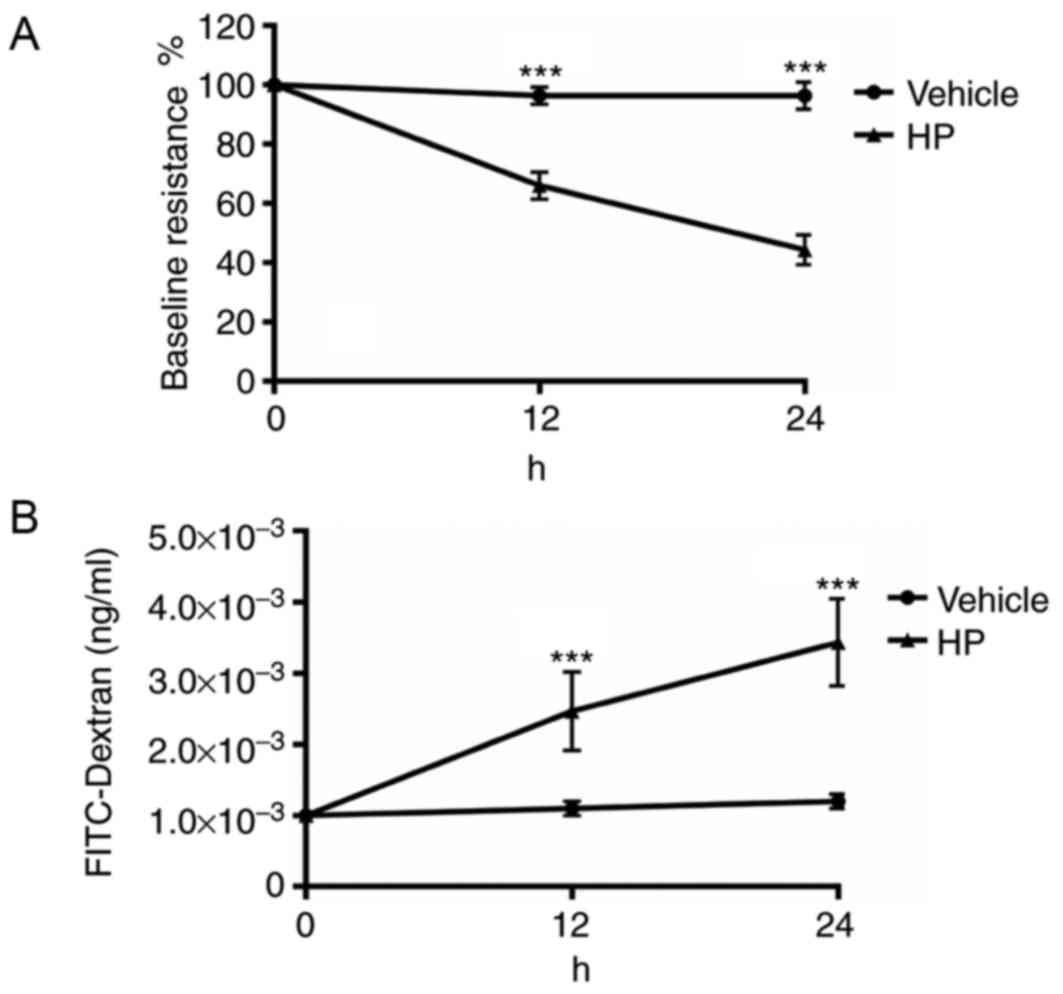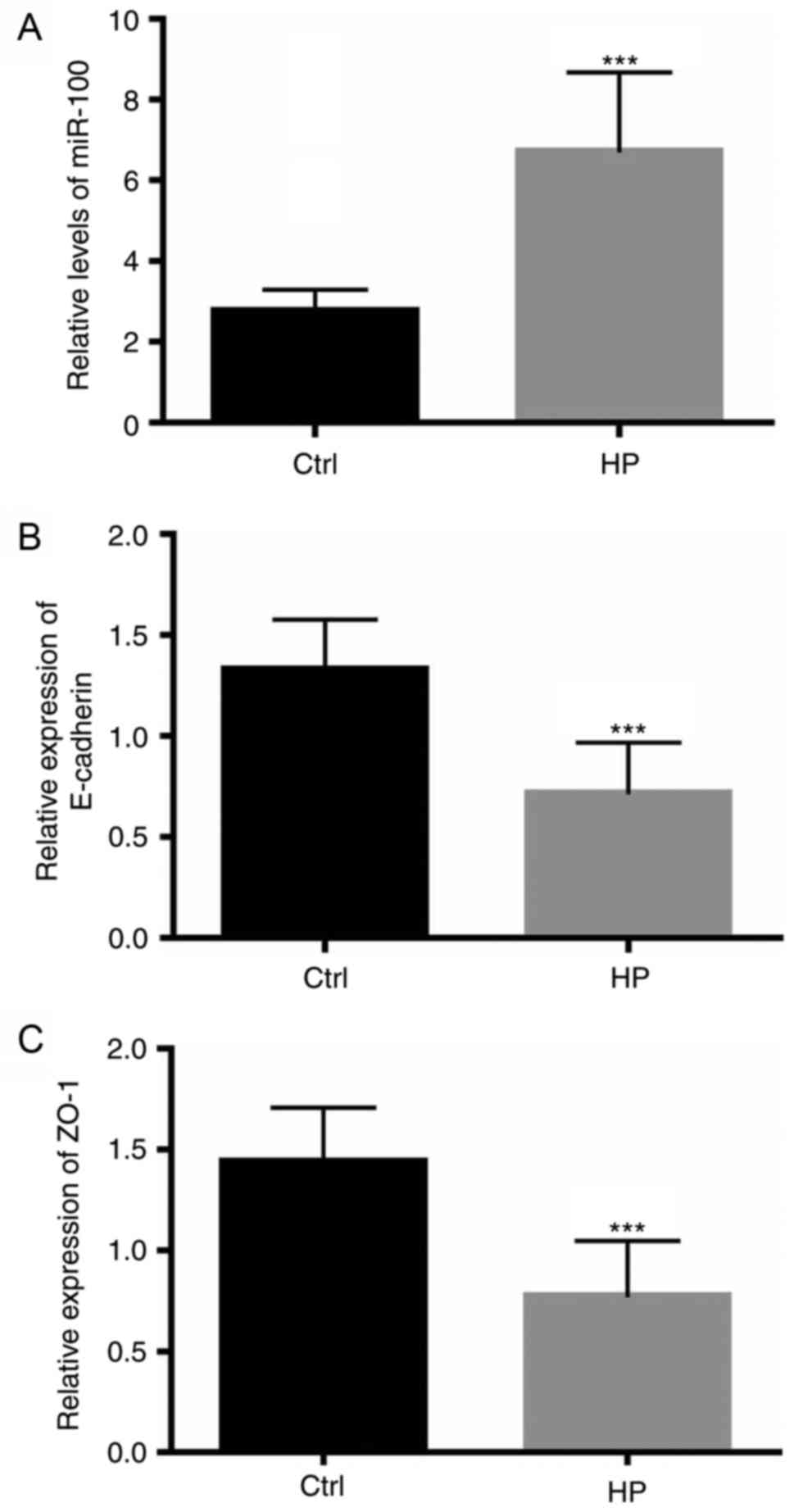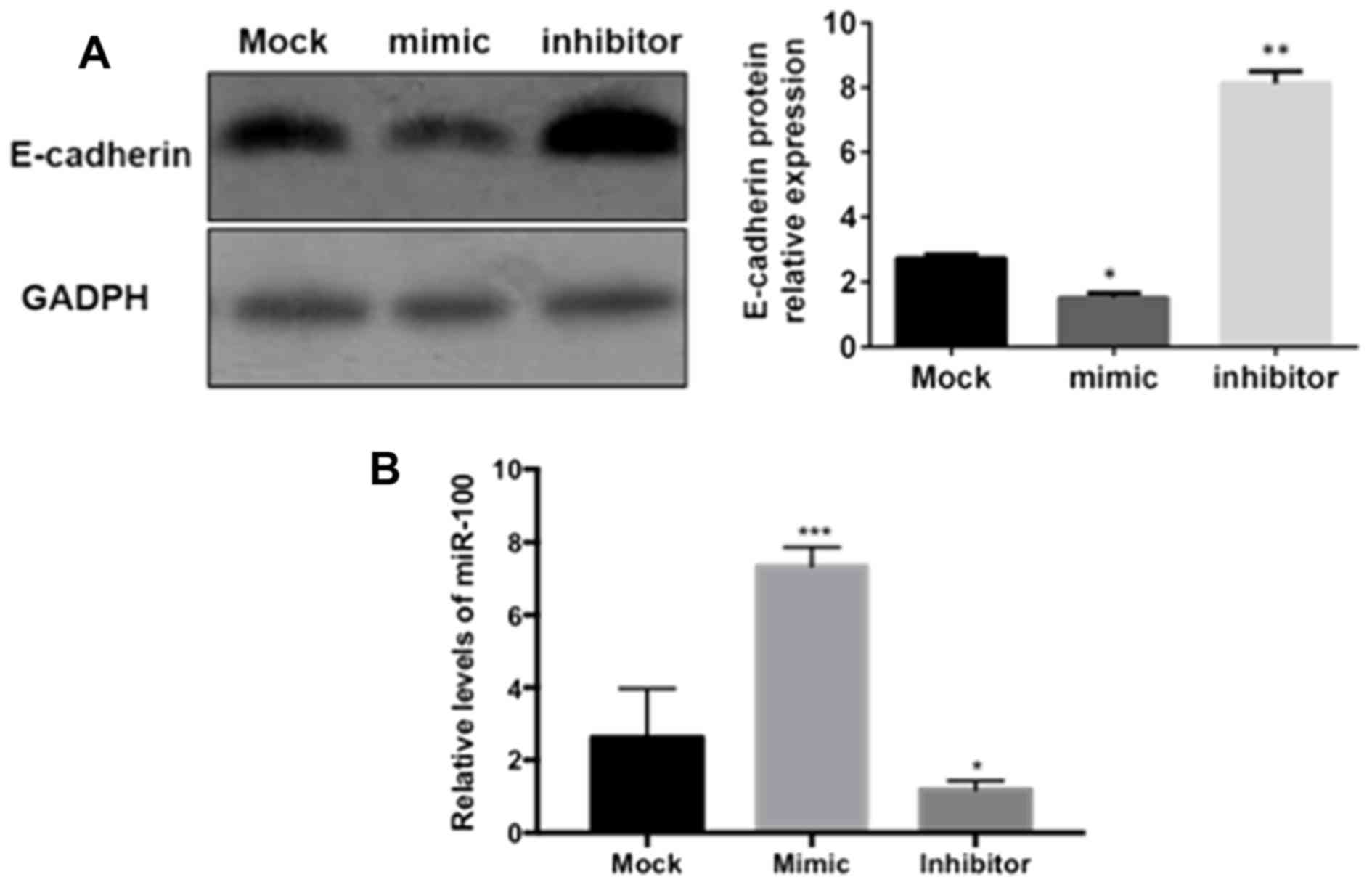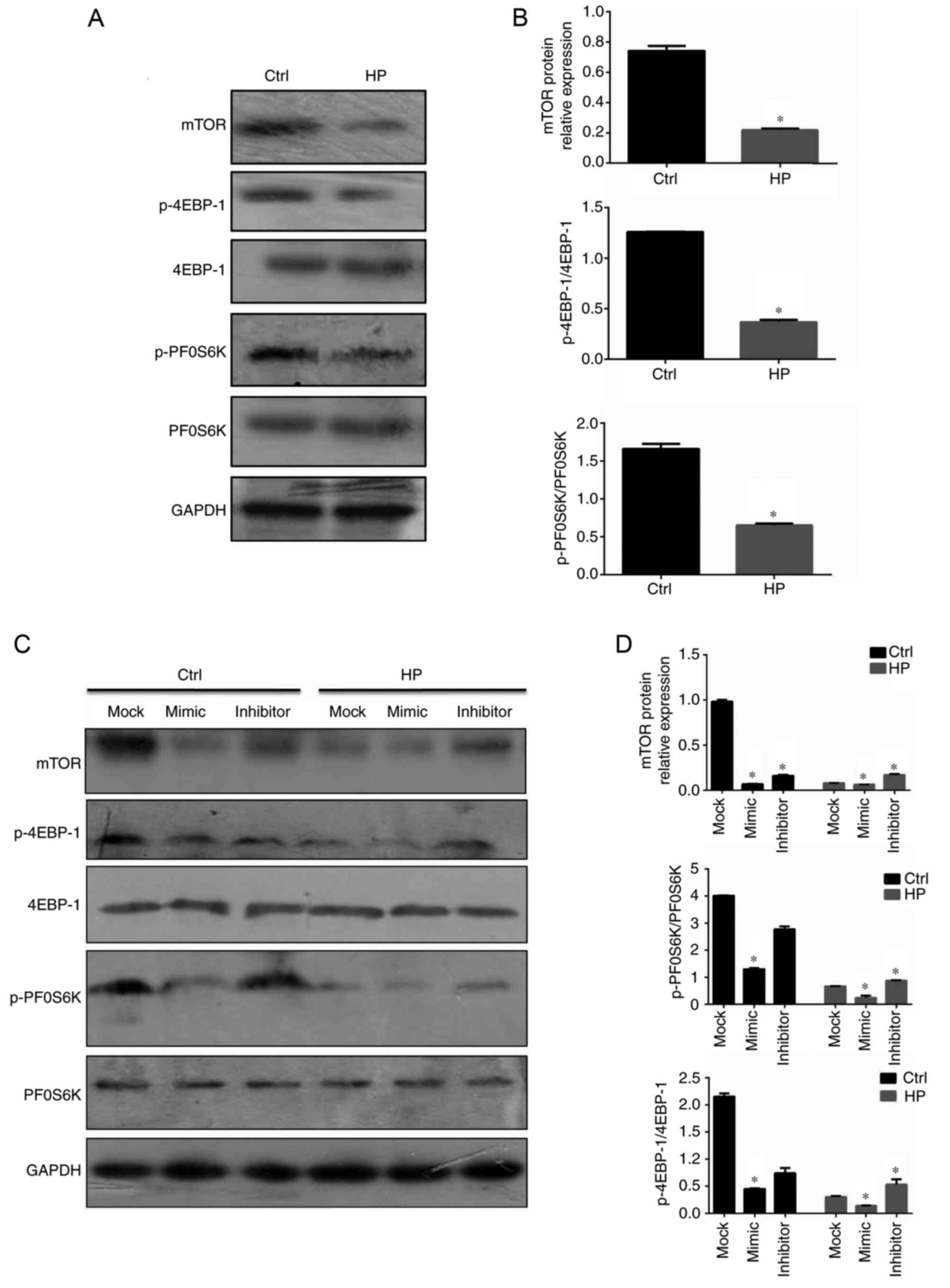Helicobacter pylori infection impairs gastric epithelial barrier function via microRNA‑100‑mediated mTOR signaling inhibition
- Authors:
- Published online on: May 4, 2018 https://doi.org/10.3892/mmr.2018.8971
- Pages: 587-594
Abstract
Introduction
Helicobacter pylori (H. pylori), which was first isolated and discovered on the surface of the gastric epithelium by Warren and Marshall in 1983 (1), is a gram-negative pathogenic bacterium. H. pylori induces chronic inflammation and epithelial damage in the stomach and duodenum. Infection induced by H. pylori usually occurs early in life and persists if left untreated (2). The prevalence of H. pylori infection has increased worldwide in the past two decades, affecting ~50% of the global population (2). H. pylori infection has been associated with a number of upper gastrointestinal disorders, including peptic ulcers in the stomach and duodenum, gastric carcinoma and gastric mucosa-associated lymphoid tissue lymphoma (3).
The precise pathophysiological process of H. pylori-induced chronic inflammation and mucosal damage, and the consequences of this chronic inflammation, remain elusive. Virulence factors of H. pylori, including the cytotoxin-associated gene A (CagA), Cag pathogenicity island (Cag PAI) and vacuolating cytotoxin A (VacA), have been widely investigated in past decades. The Cag PAI, composed of a series of genes encoding members of a type IV secretion system, is essential in the transfer of the bacterial products of H. pylori, including Cag, into host cells to mediate host cell damage (4). The portion of CagA that is translocated into host cells is phosphorylated. Phosphorylated CagA induces alterations in cell motility and proliferation (5–8), whereas secreted unphosphorylated CagA results in the impairment of epithelial barrier function (9). VagA is essential for the binding of H. pylori toxins to host cells, which disrupt the autophagy of epithelial cells, impair tight junctions between epithelial cells and enhance apoptosis (10–13). The responses of host cells to H. pylori infection, particularly the molecular mechanisms of infected cells, remain unclear.
Members of a newly discovered class of non-coding RNAs, microRNAs (miRNAs/miRs), have been demonstrated to exhibit numerous functions in health and disease (14,15). Mature miRNAs, which are composed of 19–25 nucleotides, are cleaved from precursors of 60–110 nucleotide hairpin miRNAs by the RNase III enzyme Dicer in the cytoplasm (16). Single-stranded miRNAs bind target mRNAs at the 3′-untranslated region with imperfect complementarity, which results in mRNA degradation and subsequent inhibition of translation. miRNAs have been demonstrated to exhibit numerous roles in physiological and pathological processes, including the pathogenesis of cancer.
It is well established that miR-100 is involved the pathophysiological process of various types of cancer, including ovarian (17), cervical (18) and prostate (19) cancer. However, the effects of miR-100 in the infection of H. pylori in gastric epithelial cells remain unclear. The results of the present study demonstrated that miR-100 was upregulated during H. pylori infection, and upregulation of miR-100 may mediate gastric epithelial barrier impairment via inhibition of mechanistic target of rapamycin kinase (mTOR) signaling.
Materials and methods
Ethics consideration
The Ethics Committee of The Affiliated Hospital of Medical School of Ningbo University (Ningbo, China) reviewed, approved and supervised the proposal for the present study (approval number: 2016-07-01). All participants involved in the present study gave written informed consent.
Patients and volunteers
Individuals with epigastric complaints visiting the outpatient clinic of The Affiliated Hospital of Medical School of Ningbo University were recruited in the present study. Between July 2016 and January 2017, a total of 100 age- and sex-matched volunteers and 98 patients with H. pylori infection were enrolled. The clinical features of individuals in the present study are summarized in Table I. The diagnosis of H. pylori infection was confirmed by the typical endoscopic appearance of the stomach and a positive urea breath test the day prior to gastroscopy (20). Healthy volunteers were defined as those with a normal endoscopic appearance of the stomach and a negative urea breath test. Two double-biopsies were obtained during gastroscopy from each individual.
Cell culture
The GES-1 gastric epithelial cell line was purchased from the Cell Resource Center, Shanghai Institute of Biochemistry and Cell Biology, Chinese Academy of Sciences (Shanghai, China). GES-1 cells were cultured in RPMI 1640 (Thermo Fisher Scientific, Inc., Waltham, MA, USA) supplemented with 10% fetal bovine serum (FBS; Thermo Fisher Scientific, Inc.; without any antibiotics) in an incubator at 37°C with 5% CO2. Measurements for fluorescein isothiocyanate (FITC)-dextran permeability and resistance were performed in Transwell plates according to previous publications (21,22). Briefly, GES-1 cells were seeded on the upper compartment of a Transwell chamber. At 80–90% confluency, FITC-dextran (0.5 mg/ml; purchased from Sigma-Aldrich; Merck KGaA, Darmstadt, Germany) was added into the upper apartment. The concentration of FITC in the bottom compartment was read by an infrared fluorescence laser reader (LI-COR Biosciences, Lincoln, NE, USA). The electrical resistance between the upper and lower compartments of the Transwell chambers was measured in ohms.
miR-100 mimic and inhibitor
Inhibitors for miR-100 (single-stranded chemically modified oligonucleotide) and miR-100 mimic (double-stranded oligonucleotides) were purchased from Thermo Fisher Scientific, Inc. GES-1 cells (5×106) were seeded in 75 mm2 flasks. The next day, transfection with miR-100 mimic (5′-CAAGCUUGUAUCUAUAGGUAUG-3′) or miR-100 inhibitor (5′-CAAGCUUGUAUCUAUAGGUAUG-3′) was performed using DharmaFECT 1 reagents (50 nM, GE Healthcare Dharmacon, Inc., Lafayette, CO, USA) according to the manufacturer's protocol. Control cells were treated by a mock transfection using a non-targeting miRNA sequence (5′-UCACAACCUCCUAGAAAGAGUAGA-3′). The levels of miR-100 in transfected cells were confirmed by reverse transcription-quantitative polymerase chain reaction (RT-qPCR) 24 h after transfection.
Infection of H. pylori
The H. pylori strain 7.13 (generously provided by Dr. D. Scott Mereel from Uniformed Services University of Health Services, Bethesda, MD, USA) was cultured in Brucella broth (purchased from Sigma-Aldrich; Merck KGaA, Darmstadt, Germany) with 10% FBS for 16 h at 37°C. Subsequently, H. pylori was collected by centrifugation (400 × g for 10 min at 4°C) and used to infect GES-1 cells at a bacterium-to-cell ratio of 100:11 for 24 h, as described previously (23). Control cells (referred to as Ctrl) were treated with PBS.
RT-qPCR for mature miR-100
Quantification of miRs was performed to measure the levels of mature miR-100, as described previously (24). Total RNA was extracted using a commercial RNeasy Micro kit (Qiagen, Inc., Valencia, CA, USA). RNA was reverse-transcribed to cDNA with an miR-100-specific stem-loop-like reverse transcription primer (5′-GTCGTATCCAGTGCAGGGTCCGAGGTATTCGCACTGGATACGACCACAAG-3′) using a commercial kit (High Capacity cDNA Reverse Transcription kit purchased from Thermo Fisher Scientific, Inc.), according to the manufacturer's protocol. qPCR was subsequently performed with SYBR Green Master Mix (Thermo Fisher Scientific, Inc.) using the following primers: Forward primer, 5′-GAGCCAACCCGTAGATCCGA-3′; and reverse primer, 5′-GTGCAGGGTCCGAGGT-3′. The accuracy of the PCR amplification of the mature miR-100 sequences was verified by sequencing using Applied Biosystems 3730×l 96 capillary DNA Analyzer (Applied Biosystems; Thermo Fisher Scientific, Inc.). Small nuclear RNA U6 was used as a housekeeping gene. Relative expression of miR-100 was normalized with the 2−ΔΔCq method (25).
For qPCR analyses of mRNAs of interest, total RNA (2 µg) was reverse-transcribed to cDNA using an RT-PCR kit (Verso 1-step RT-PCR kit ReddyMix; Thermo Fisher Scientific, Inc.) at 55°C according to the manufacturer's protocol. The expression of the genes of interest and the housekeeping gene hypoxanthine phosphoribosyltransferase was measured using a SYBR Green Master Mix (94°C for 2 min, 40 cycles of 94°C for 15 sec and 60°C for 1 min), according to the manufacturer's protocol. The sequences of primers are listed in Table II. Quantification of each mRNA was performed using the 2−ΔΔCq method.
Table II.Primer sequences for reverse transcription-quantitative polymerase chain reaction of mRNAs. |
Western blotting
Whole-cell lysates from biopsies or cultured cells were lysed in 30 µl lysis buffer [1% Triton X-100, 0.5% Nonidet P-40, 10 mM Tris-HCl, 150 mM NaCl, (pH 7.4), 1 mM EDTA, 1 mM EGTA, 0.2 mM phenylmethylsulfonyl fluoride]. A total of 50 µg protein measured by Lowry assays was resolved by SDS-PAGE and subsequently transferred to nitrocellulose membranes. Membranes were blocked in 5% fat-free milk for 1 h at room temperature. Membranes were then incubated with primary antibodies against epithelial (E)-cadherin (1:10,000; cat. no. ab40772; Abcam, Cambridge, MA, USA), zona occludens-1 (ZO-1; 1:1,000; cat. no. ab59720; Abcam), mTOR (1:1,000; cat. no. 2983; Cell Signaling Technology, Inc., Danvers, MA, USA), phosphorylated-eukaryotic translation initiation factor 4E-binding protein 1 (P-4EBP-1; 1:1,000; cat. no. 9459, Cell Signaling Technology, Inc.), 4EBP-1 (1:1,000; cat. no. 9452, Cell Signaling Technology, Inc.), p-P70S6K (1:1,000; cat. no. 9204; Cell Signaling Technology, Inc.) and P70S6K (1:1,000; cat. no. 9202; Cell Signaling Technology, Inc.) at the optimized titrations at 4°C overnight. Following incubation with corresponding horseradish peroxidase-conjugated secondary antibodies (anti-rabbit secondary antibody, 1:10,000; cat. no. ab6721); anti-goat secondary antibody, 1:5,000; cat. no. ab6885; Both were purchased from Abcam) at room temperature for 30 min, the bands were visualized using an enhancing chemiluminescence system (Amershan ECL Western Blotting Detection kit, GE Healthcare, Chicago, IL, USA). Densitometric analysis was performed with ImageJ software (Windows Edition, 1.35j, National Institutes of Health, Bethesda, MD, USA).
Statistical analysis
Data are presented as the mean ± the standard error of the mean. The difference between two groups was analyzed using a two-tailed student's t-test. The statistical significance between >2 groups was measured by one-way analysis of variance followed by Bonferroni's post-hoc tests. Statistical analysis was performed by GraphPad Prism 5 Windows Edition (GraphPad Software, Inc., La Jolla, CA, USA). All experiments were performed with a minimum of three times. P<0.05 was considered to indicate a statistically significant difference.
Results
Patients with H. pylori infection exhibit increased miR-100 levels and reduced expression of junction proteins
The present study initially investigated whether miR-100 may be involved in the pathophysiological process of H. pylori-mediated gastric epithelium infection. Individuals with epigastric complaints visiting the outpatient clinic of The Affiliated Hospital of Medical School of Ningbo University, who underwent upper gastrointestinal endoscopy, were recruited to the present study. H. pylori infection was confirmed or excluded by a urea breath test and the endoscopic appearance of the gastric mucosa. A total of 100 healthy controls without H. pylori infection and 98 patients infected with H. pylori were analyzed. Two double-biopsies under endoscopy were obtained from each individual. The level of miR-100 was assessed by RT-qPCR, as described above. The expression of miR-100 in the gastric mucosa of patients with H. pylori infection was significantly upregulated compared with infection-free individuals (P<0.0001; Fig. 1A). As the adherens junctions and tight junctions have an important role as a barrier to prevent the influx of luminal contents into the lamina propria (26), the mRNA levels of E-cadherin and ZO-1, important components of the adherens junctions and tight junctions, respectively, were also measured. As illustrated in Fig. 1B and C, in patients with H. pylori infections, the mRNA levels of E-cadherin and ZO-1 significantly decreased (P<0.0001), indicating an impaired barrier function of the gastric epithelium compared with infection-free controls. The protein expression levels of E-cadherin and ZO-1 in patients with H. pylori infection were also measured using western blotting, which demonstrated that patients with H. pylori infection exhibited decreased levels of the proteins of the adherens and tight junctions (Fig. 1D and E).
H. pylori infection increases gastric epithelial monolayer permeability in vitro
As H. pylori infection decreased the expression of E-cadherin and ZO-1 in the gastric epithelium, which are vital for maintaining normal gastric epithelial barrier function, the permeability of the cultured gastric epithelial monolayer was assessed. The resistance of cultured GES-1 cells treated with a PBS vehicle or H. pylori for 1 h was checked. After 12 and 24 h of infection, the resistance of the cultured cell monolayer was measured. The resistance prior to infection was used as the baseline value. As demonstrated in Fig. 2A, cultured GES-1 gastric epithelial cells had a significantly decreased level of resistance in the H. pylori group compared with the vehicle (P<0.001). FITC-dextran in the lower chamber of Transwells used for the culture of GES-1 cells was also measured. As illustrated in Fig. 2B, the lower chamber of the Transwell in which gastric epithelial cells were infected with H. pylori had significantly increased levels of FITC-dextran after 12 and 24 h of infection (P<0.001). Results from both the resistance and FITC-dextran assays indicated that gastric epithelial cells infected with H. pylori had increased permeability compared with controls.
H. pylori infection increases the levels of miR-100 and decreases the expression of E-cadherin and ZO-1 in vitro
The present study further investigated whether impaired barrier function of infected gastric epithelial cells in vitro may be a result of miR-100-mediated reduction of E-cadherin and ZO-1 expression. The levels of miR-100, as well as the mRNA and protein expression of E-cadherin and ZO-1 junction proteins, was assessed in cultured GES-1 gastric epithelial cells infected with H. pylori. As demonstrated in Fig. 3A, the levels of miR-100 in cells infected with H. pylori were significantly elevated compared with control cells (P<0.001). However, the mRNA levels of E-cadherin and ZO-1 were significantly downregulated in infected cells (P<0.001; Fig. 3B and C). Notably, the protein levels of these two junction proteins were also decreased in infected cells (data not shown). These data indicate the possibility that increased miR-100 levels induced by H. pylori infection may mediate the downregulation of E-cadherin and ZO-1 expression.
miR-100 mediates the inhibition of E-cadherin and ZO-1 expression
In order to investigate the effects of miR-100 on the expression of E-cadherin and ZO-1 in vitro, ‘loss-of-function’ and ‘gain-of-function’ protocols were used to inhibit or overexpress miR-100 in GES-1 gastric epithelial cells. As demonstrated in Fig. 4, E-cadherin protein was significantly downregulated in gastric epithelial cells transfected with miR-100 mimic (P<0.05), while the protein expression of E-cadherin was significantly increased in cells transfected with the miR-100 inhibitor (P<0.01), compared with the mock group, as measured by western blotting. A similar effect of miR-100 on the expression of ZO-1 in gastric epithelial cells was also observed in the present study (data not shown).
mTOR is the downstream signaling molecule involved in miR-100-mediated regulation of E-cadherin and ZO-1
It is well established that the mTOR signaling pathway regulates the epithelial barrier function, including the expression of the adherens junctions and tight junctions (27,28). The activation status of mTOR signaling in gastric epithelial cells infected with H. pylori was therefore assessed in the current study. As demonstrated in Fig. 5A, in contrast to the levels of miR-100 in infected gastric epithelial cells, mTOR and the downstream active forms of 4EBP-1 and PF0S6K were downregulated (Fig. 5A and B). In order to assess the effects of miR-100 on the activation of mTOR signaling, the same protocols of overexpression and suppression of miR-100 in GES-1 cells were employed. The mimic of miR-100 significantly inhibited the mTOR signaling pathway in infected gastric epithelial cells; however, suppression of miR-100 significantly increased the activation of this pathway, compared with mock-treated cells (P<0.05; Fig. 5C and D). These data indicated that miR-100 may be a negative regulator of mTOR signaling in tuning the barrier functions.
Discussion
In the present study, the role of miR-100 in the impaired functioning of gastric epithelial cells infected with H. pylori was described. The results of the present study indicated that patients, as well as cultured cells in vitro, infected with H. pylori exhibited increased levels of miR-100 and decreased expression of junction-proteins. Furthermore, cultured gastric epithelial cells infected with H. pylori exhibited impaired barrier functions and mTOR signaling was demonstrated to be controlled by an upregulation of miR-100.
Infections induced by H. pylori are a huge public health burden. H. pylori infection has been reported to be implicated in gastritis, precancerous lesions and gastric carcinoma (29). The eventual consequence of H. pylori infection, gastric carcinoma, is the third leading cause of cancer-associated mortality worldwide. As the association between H. pylori infection and gastric carcinoma has become clear, H. pylori has been demonstrated to be the most common pathogen that is associated with malignancy (30). The process from chronic H. pylori infection to gastric carcinoma is complex and involves a number of molecular and cellular events, some of which remains inclusive (31). Although the pathogenesis of H. pylori has been investigated thoroughly, the responses of host epithelial cells and intracellular molecular events require further attention.
Based on the results of the present study, part of the host gastric epithelial cell response to H. pylori infection may be described as follows. Following infection, levels of miR-100 are upregulated, this miR-100 upregulation may suppress the activation of the mTOR signaling pathway, which subsequently downregulates the expression of the adherens and tight junction proteins E-cadherin and ZO-1, respectively. Decreased expression of junction proteins leads to an impaired barrier function, which was indicated in the present study as decreased resistance and an increased permeability level were observed in monolayer gastric epithelial cells infected with H. pylori. It may be hypothesized that an impaired gastric epithelial barrier function will result in the influx of gastric contents to the lamina propria of the stomach, subsequently inducing chronic and persistent inflammation. Chronic inflammation has been positively associated with the onset of cancer (32), therefore, miR-100 may be involved in gastric oncogenesis. However, the mechanism by which miR-100 is upregulated in gastric epithelial cells infected with H. pylori remains unknown at present, and the regulation of miR-100 in H. pylori infection requires investigation in the near future.
miRNAs are single-stranded RNA molecules that are 20–23 nucleotides in length. miRNAs control gene expression in numerous cellular processes, including inflammation, cell cycle regulation, stress differentiation, apoptosis, proliferation and tumorigenesis (33). As a member of the miRNA family, miR-100 has gained interest from biologists and oncologists. miR-100 has been demonstrated to be associated with ovarian (17), cervical (18) and prostate (19) cancer. To the best of our knowledge, the present study is the first to demonstrate that upregulation of miR-100, as part of the host epithelial cell response to H. pylori infection, may mediate impaired gastric barrier functions by inhibiting mTOR signaling. These data expand on the current understanding of host responses to H. pylori infection.
However, there are a number of limitations associated with the present study. As mentioned above, the mechanism by which miR-100 is upregulated during H. pylori infection was not investigated. In addition, the mechanism by which miR-100 regulates E-cadherin and ZO-1 expression is yet to be established. When the ‘loss-of-function’ and ‘gain-of function’ assays were performed for miR-100, the mRNA levels of E-cadherin and ZO-1 were also determined in addition to the protein levels, which indicated lower levels of mRNA in ‘gain-of-function’ assays and increased levels of mRNA in ‘loss-of-function’ assays (data not shown). Although these data indicate that miR-100 may affect the transcription of E-cadherin and ZO-1, the precise underlying mechanisms of this process require investigation in the future.
In conclusion, the results of the current study indicated that miR-100 may impair the gastric epithelial barrier function by affecting mTOR signaling in H. pylori infection.
Acknowledgements
Not applicable.
Funding
The present study was supported by the Natural Science Foundation of Ningbo City (grant no. 2016A610122). The funding organization had no roles in the study design, data collection and analysis, manuscript preparation or publication decision.
Availability of data and materials
The datasets used and/or analyzed during the current study are available from the corresponding author on reasonable request.
Authors' contributions
GH designed this study, performed most experiments, and prepared the first draft; LG performed some of repeated experiments, and performed data analysis. GY designed this study, supervised this study, and reviewed the draft.
Ethics approval and consent to participate
The present study was approved by the Ethics Committee of The Affiliated Hospital of Medical School of Ningbo University, China (approval number: 2016-07-01). All participants involved in the present study gave written informed consent.
Consent for publication
Not applicable.
Competing interests
The authors declare that they have no competing interests.
References
|
Warren JR and Marshall B: Unidentified curved bacilli on gastric epithelium in active chronic gastritis. Lancet. 1:1273–1275. 1983.PubMed/NCBI | |
|
Everhart JE: Recent developments in the epidemiology of Helicobacter pylori. Gastroenterol Clin North Am. 29:559–578. 2000. View Article : Google Scholar : PubMed/NCBI | |
|
McColl KE: Clinical practice. Helicobacter pylori infection. N Engl J Med. 362:1597–1604. 2010. View Article : Google Scholar : PubMed/NCBI | |
|
Censini S, Lange C, Xiang Z, Crabtree JE, Ghiara P, Borodovsky M, Rappuoli R and Covacci A: cag, a pathogenicity island of Helicobacter pylori, encodes type I-specific and disease-associated virulence factors. Proc Natl Acad Sci USA. 93:14648–14653. 1996. View Article : Google Scholar : PubMed/NCBI | |
|
Selbach M, Moese S, Hauck CR, Meyer TF and Backert S: Src is the kinase of the Helicobacter pylori CagA protein in vitro and in vivo. J Biol Chem. 277:6775–6778. 2002. View Article : Google Scholar : PubMed/NCBI | |
|
Tammer I, Brandt S, Hartig R, König W and Backert S: Activation of Abl by Helicobacter pylori: A novel kinase for CagA and crucial mediator of host cell scattering. Gastroenterology. 132:1309–1319. 2007. View Article : Google Scholar : PubMed/NCBI | |
|
Backert S, Moese S, Selbach M, Brinkmann V and Meyer TF: Phosphorylation of tyrosine 972 of the Helicobacter pylori CagA protein is essential for induction of a scattering phenotype in gastric epithelial cells. Mol Microbiol. 42:631–644. 2001. View Article : Google Scholar : PubMed/NCBI | |
|
Mueller D, Tegtmeyer N, Brandt S, Yamaoka Y, De Poire E, Sgouras D, Wessler S, Torres J, Smolka A and Backert S: c-Src and c-Abl kinases control hierarchic phosphorylation and function of the CagA effector protein in Western and East Asian Helicobacter pylori strains. J Clin Invest. 122:1553–1566. 2012. View Article : Google Scholar : PubMed/NCBI | |
|
Saadat I, Higashi H, Obuse C, Umeda M, Murata-Kamiya N, Saito Y, Lu H, Ohnishi N, Azuma T, Suzuki A, et al: Helicobacter pylori CagA targets PAR1/MARK kinase to disrupt epithelial cell polarity. Nature. 447:330–333. 2007. View Article : Google Scholar : PubMed/NCBI | |
|
Palframan SL, Kwok T and Gabriel K: Vacuolating cytotoxin A (VacA), a key toxin for Helicobacter pylori pathogenesis. Front Cell Infect Microbiol. 2:922012. View Article : Google Scholar : PubMed/NCBI | |
|
Jain P, Luo ZQ and Blanke SR: Helicobacter pylori vacuolating cytotoxin A (VacA) engages the mitochondrial fission machinery to induce host cell death. Proc Natl Acad Sci USA. 108:16032–16037. 2011. View Article : Google Scholar : PubMed/NCBI | |
|
Rassow J and Meinecke M: Helicobacter pylori VacA: A new perspective on an invasive chloride channel. Microbes Infect. 14:1026–1033. 2012. View Article : Google Scholar : PubMed/NCBI | |
|
Boquet P and Ricci V: Intoxication strategy of Helicobacter pylori VacA toxin. Trends Microbiol. 20:165–174. 2012. View Article : Google Scholar : PubMed/NCBI | |
|
Lagos-Quintana M, Rauhut R, Lendeckel W and Tuschl T: Identification of novel genes coding for small expressed RNAs. Science. 294:853–858. 2001. View Article : Google Scholar : PubMed/NCBI | |
|
Bartel DP: MicroRNAs: Target recognition and regulatory functions. Cell. 136:215–233. 2009. View Article : Google Scholar : PubMed/NCBI | |
|
Bartel DP: MicroRNAs: Genomics, biogenesis, mechanism, and function. Cell. 116:281–297. 2004. View Article : Google Scholar : PubMed/NCBI | |
|
Nagaraja AK, Creighton CJ, Yu Z, Zhu H, Gunaratne PH, Reid JG, Olokpa E, Itamochi H, Ueno NT, Hawkins SM, et al: A link between mir-100 and FRAP1/mTOR in clear cell ovarian cancer. Mol Endocrinol. 24:447–463. 2010. View Article : Google Scholar : PubMed/NCBI | |
|
Li BH, Zhou JS, Ye F, Cheng XD, Zhou CY, Lu WG and Xie X: Reduced miR-100 expression in cervical cancer and precursors and its carcinogenic effect through targeting PLK1 protein. Eur J Cancer. 47:2166–2174. 2011. View Article : Google Scholar : PubMed/NCBI | |
|
Leite KR, Sousa-Canavez JM, Reis ST, Tomiyama AH, Camara-Lopes LH, Sañudo A, Antunes AA and Srougi M: Change in expression of miR-let7c, miR-100 and miR-218 from high grade localized prostate cancer to metastasis. Urol Oncol. 29:265–269. 2011. View Article : Google Scholar : PubMed/NCBI | |
|
Wei Y, Wang T, Song H, Tian L, Lyu G, Zhao L and Xue Y: C-C motif chemokine 22 ligand (CCL22) concentrations in sera of gastric cancer patients are related to peritoneal metastasis and predict recurrence within one year after radical gastrectomy. J Surg Res. 211:266–278. 2017. View Article : Google Scholar : PubMed/NCBI | |
|
Temmesfeld-Wollbrück B, Brell B, zu Dohna C, Dorenberg M, Hocke AC, Martens H, Klar J, Suttorp N and Hippenstiel S: Adrenomedullin reduces intestinal epithelial permeability in vivo and in vitro. Am J Physiol Gastrointest Liver Physiol. 297:G43–G51. 2009. View Article : Google Scholar : PubMed/NCBI | |
|
Oshima T, Miwa H and Joh T: Aspirin induces gastric epithelial barrier dysfunction by activating p38 MAPK via claudin-7. Am J Physiol Cell Physiol. 295:C800–C806. 2008. View Article : Google Scholar : PubMed/NCBI | |
|
Franco AT, Israel DA, Washington MK, Krishna U, Fox JG, Rogers AB, Neish AS, Collier-Hyams L, Perez-Perez GI, Hatakeyama M, et al: Activation of beta-catenin by carcinogenic Helicobacter pylori. Proc Natl Acad Sci USA. 102:10646–10651. 2005. View Article : Google Scholar : PubMed/NCBI | |
|
Hou J, Wang P, Lin L, Liu X, Ma F, An H, Wang Z and Cao X: MicroRNA-146a feedback inhibits RIG-I-dependent Type I IFN production in macrophages by targeting TRAF6, IRAK1, and IRAK2. J Immunol. 183:2150–2158. 2009. View Article : Google Scholar : PubMed/NCBI | |
|
Livak KJ and Schmittgen TD: Analysis of relative gene expression data using real-time quantitative PCR and the 2(-Delta Delta C(T)) method. Methods. 25:402–408. 2001. View Article : Google Scholar : PubMed/NCBI | |
|
Hartsock A and Nelson WJ: Adherens and tight junctions: Structure, function and connections to the actin cytoskeleton. Biochim Biophys Acta. 1778:660–669. 2008. View Article : Google Scholar : PubMed/NCBI | |
|
Sampson LL, Davis AK, Grogg MW and Zheng Y: mTOR disruption causes intestinal epithelial cell defects and intestinal atrophy postinjury in mice. FASEB J. 30:1263–1275. 2016. View Article : Google Scholar : PubMed/NCBI | |
|
Kaser A and Blumberg RS: Autophagy, microbial sensing, endoplasmic reticulum stress, and epithelial function in inflammatory bowel disease. Gastroenterology. 140:1738–1747. 2011. View Article : Google Scholar : PubMed/NCBI | |
|
Ajani JA, Lee J, Sano T, Janjigian YY, Fan D and Song S: Gastric adenocarcinoma. Nat Rev Dis Primers. 3:170362017. View Article : Google Scholar : PubMed/NCBI | |
|
de Martel C, Ferlay J, Franceschi S, Vignat J, Bray F, Forman D and Plummer M: Global burden of cancers attributable to infections in 2008: A review and synthetic analysis. Lancet Oncol. 13:607–615. 2012. View Article : Google Scholar : PubMed/NCBI | |
|
Polk DB and Peek RM Jr: Helicobacter pylori: Gastric cancer and beyond. Nat Rev Cancer. 10:403–414. 2010. View Article : Google Scholar : PubMed/NCBI | |
|
Grivennikov SI, Greten FR and Karin M: Immunity, inflammation, and cancer. Cell. 140:883–899. 2010. View Article : Google Scholar : PubMed/NCBI | |
|
Croce CM: Causes and consequences of microRNA dysregulation in cancer. Nat Rev Genet. 10:704–714. 2009. View Article : Google Scholar : PubMed/NCBI |



